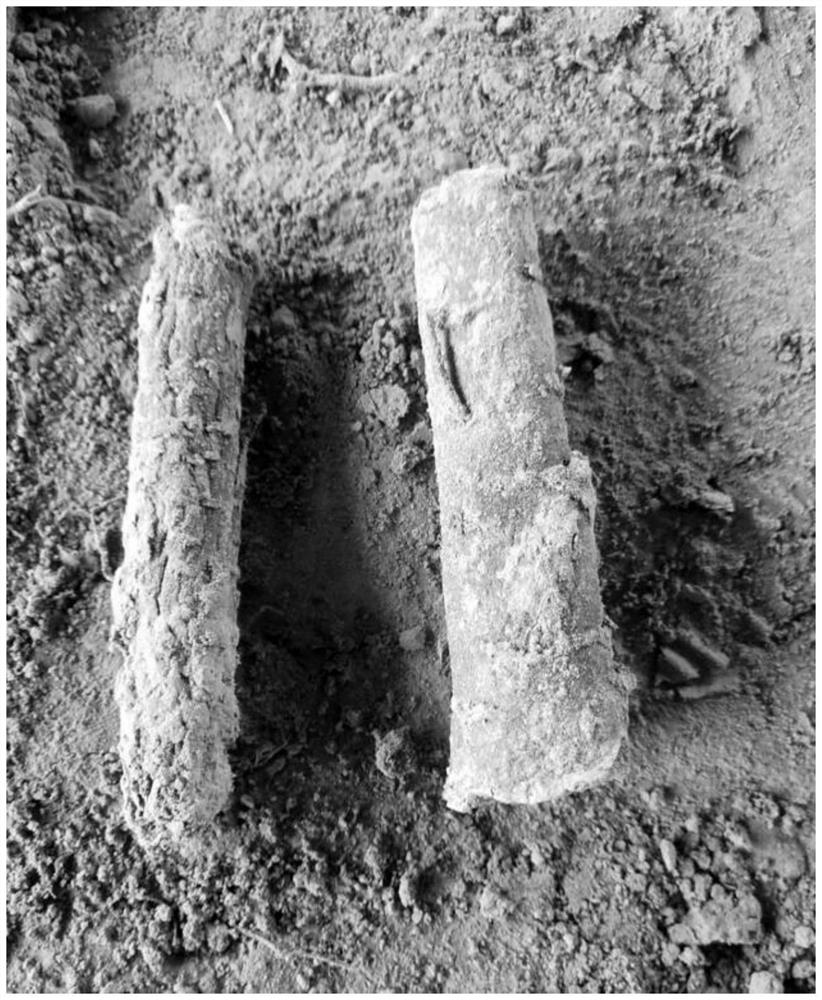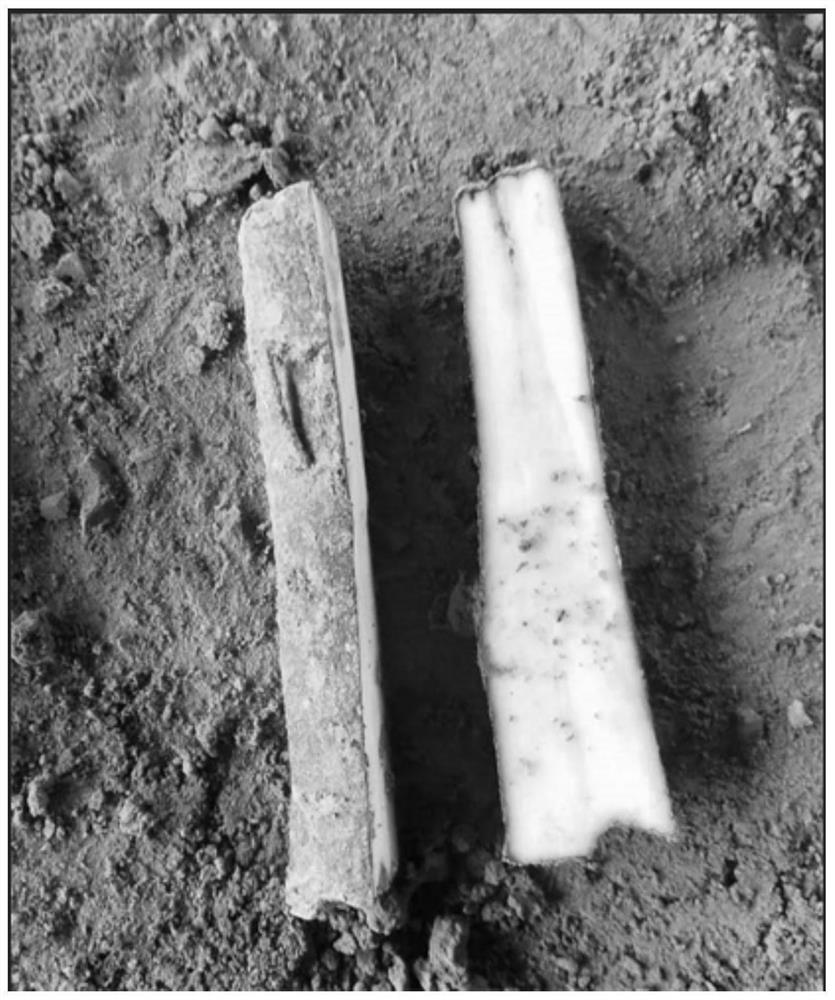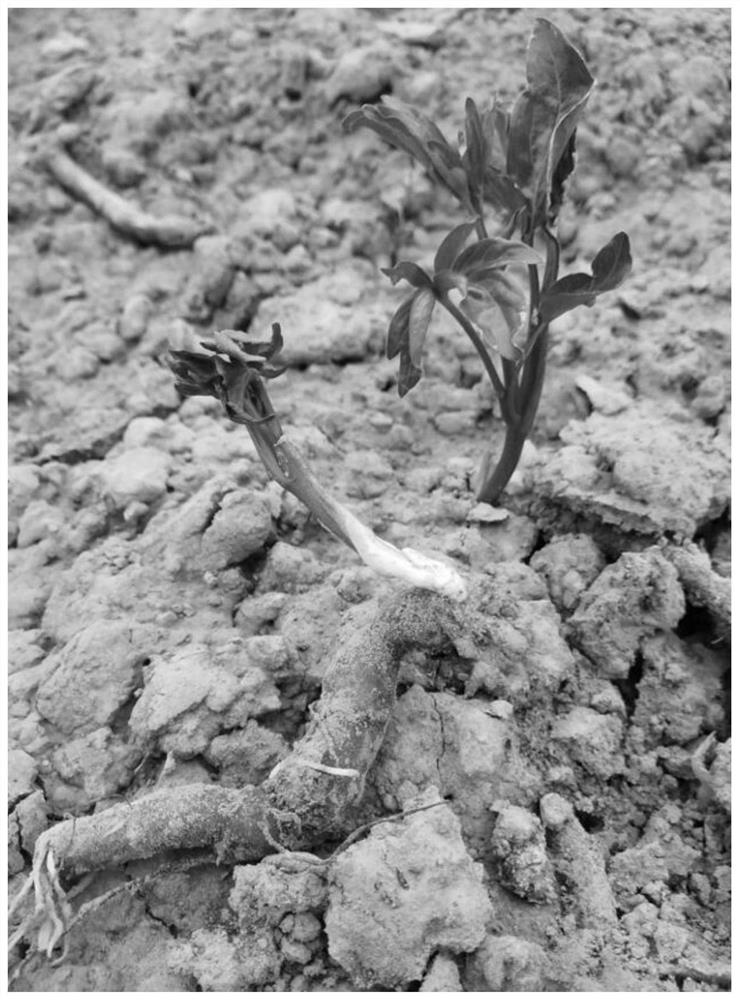Paeonia lactiflora breeding method
A peony and planting method technology, which is applied in the cultivation of root crops, seed and rhizome treatment, flower cultivation, etc., can solve the problem of low planting coefficient of the division method, and achieve the effect of improving the reproductive efficiency of peony, simple operation, and fast propagation speed
- Summary
- Abstract
- Description
- Claims
- Application Information
AI Technical Summary
Problems solved by technology
Method used
Image
Examples
Embodiment 1
[0032] The invention provides a peony propagation method. Including the following steps: 1)-3);
[0033] 1), intercept the rhizome of peony, and remove the excess capillary roots on it;
[0034] Among them, the root of peony is composed of three parts, namely root neck, tuberous root and fibrous root. The root neck is located at the uppermost part of the root, which is the position where the buds grow; the tuberous root grows from the bottom of the root neck, the flesh is thick, spindle-shaped or long, ranging from 0.8 to 4 cm in diameter, rich in nutrition, and does not directly sprout; the fibrous roots grow from the Root tubers are born, which are the main organs for absorbing nutrients and water, and can gradually evolve into tubers. In the present invention, the selected ones are mainly rhizomes.
[0035] It should be noted that the rhizome of the peony is taken from the plant more than 2 years after planting by division, and the length of the rhizome is 15-20 cm, and ...
Embodiment 2
[0042] The invention provides a peony propagation method. Including the following steps: 1)-4);
[0043] 1), intercept the rhizome of peony, and remove the excess capillary roots on it;
[0044] Among them, the root of peony is composed of three parts, namely root neck, tuberous root and fibrous root. The root neck is located at the uppermost part of the root, which is the position where the buds grow; the tuberous root grows from the bottom of the root neck, the flesh is thick, spindle-shaped or long, ranging from 0.8 to 4 cm in diameter, rich in nutrition, and does not directly sprout; the fibrous roots grow from the Root tubers are born, which are the main organs for absorbing nutrients and water, and can gradually evolve into tubers. In the present invention, the selected ones are mainly rhizomes.
[0045] It should be noted that the rhizome of the peony is taken from the plant more than 2 years after planting by division, and the length of the rhizome is 15-20 cm, and ...
Embodiment 3
[0066] The obtained rhizomes are cut into sections for field planting.
[0067] Traditionally speaking, peony propagation is generally carried out from September to October, or even only from late September to early October. And by the peony propagation method of the present invention, the field planting can be carried out every month in a year.
[0068] Described field planting comprises the steps:
[0069] Further, preferably, if the head and root of Paeoniae Alba are not propagated immediately after they are selected, they must be stored. Specifically, it needs to be cut and loaded. If the planting is not complete, the ramets can be stored in the bunker for artificial planting. Its storage method: In a dry, cool and ventilated room, spread 2-3 inches of moist sand on the flat ground first, and pile the heads and roots of peony root on it, with a thickness of about 4-5 inches. Upwards, put them on an incline in order, cover with moist sand 2-3 inches thick, and surround t...
PUM
| Property | Measurement | Unit |
|---|---|---|
| Length | aaaaa | aaaaa |
| Diameter | aaaaa | aaaaa |
| Length | aaaaa | aaaaa |
Abstract
Description
Claims
Application Information
 Login to View More
Login to View More - Generate Ideas
- Intellectual Property
- Life Sciences
- Materials
- Tech Scout
- Unparalleled Data Quality
- Higher Quality Content
- 60% Fewer Hallucinations
Browse by: Latest US Patents, China's latest patents, Technical Efficacy Thesaurus, Application Domain, Technology Topic, Popular Technical Reports.
© 2025 PatSnap. All rights reserved.Legal|Privacy policy|Modern Slavery Act Transparency Statement|Sitemap|About US| Contact US: help@patsnap.com



